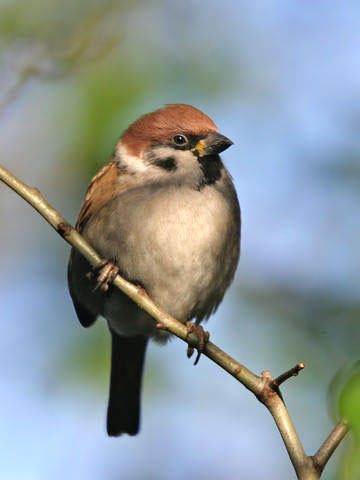
Tree Sparrow © Steve Round
The Atlas results for this species were awaited with more trepidation than most, as its numbers have declined more steeply in the last thirty years than any other English bird. In the event, many observers commented that they found Tree Sparrows in areas where they had not known them before, their presence often given away by a series of ‘chup’ calls from deep in a hedge: the species is quite secretive and probably under-recorded in casual birdwatching, as Boyd commented 60 years ago (Boyd 1951).
Tree Sparrow abundance dropped spectacularly in the UK between the late 1970s and the early 1990s. Most of the population crash occurred during the period of our First Atlas, so that the national index fell by three-quarters during 1978-84, and continued to decline into the mid-1990s but has risen a little since then. It appears that the low point in their Cheshire and Wirral fortunes probably occurred about half-way between our two Atlases. This species has been hit hard by agricultural intensification, especially the loss of weedy winter stubble, and it seems that Countryside Stewardship agri-environment scheme is helping to turn round their fortunes. The ‘change’ map, although showing the species lost from 246 tetrads since our First Atlas, does illustrate 44 gains, mainly in the cattle-farming areas of southern Cheshire.
Most Tree Sparrows nest in loose colonies, with some solitary pairs. Cheshire birds appear to be mainly in groups of 5-10 pairs, although 10-50 used to be the normal size (Summers-Smith 1995) and the UK BAP considers a ‘large’ colony to be one exceeding 20 pairs, possibly worthy of site safeguard measures. Colonies are not dense aggregations, and indeed a casual visitor might not realise that there is more than one or two nests. A typical colony covers an area of 5 to 20 ha, a diameter of 250-500 m, the size usually limited by the number of available holes for nesting and the amount of suitable food in the vicinity. On a local scale, they show a preference for damp areas, especially for finding copious invertebrates, although breeding adults may fly more than 1 km to suitable sources of food. Provision of nest-boxes, preferably situated with a few close together, can help in building up numbers, even starting from scratch, but studies elsewhere have shown that it might take six years or more before the birds respond and establish a colony.
[Tree Sparrows pair for life, and remain faithful to the same nest site. As they usually spend the winter not far away from the nest site, breeding activity can start promptly, although they are not particularly early nesters: their breeding season can extend from April to August, most pairs having more than one brood. Three-quarters of pairs have a second brood and about 40% have a third. They do not hang about: on average, about a week after the first chicks leaving the nest, the female has started laying the next eggs. Open nests, in hedges, can be used but in Britain more than 90% of nests of this species are in holes, in trees, and in nest-boxes. The untidy nest, a tangle of grasses, fills the cavity and usually feels very warm owing to the lining of feathers. The female typically lays 5 eggs, incubated for about 13 days by both parents. Chicks grow rapidly on their protein-rich diet of invertebrates, especially caterpillars, flies and beetles, and are in the nest for about 12-14 days (Summers-Smith 1995).]
The breeding population estimate for Cheshire and Wirral in 2004-05 from the BBS analysis is 4,350 (2,100-6,600) individuals. Although probably not as scarce in the county as many observers had feared, it must be remembered that just a quarter of a century ago they were probably amongst the top ten commonest birds in Cheshire. This figure gives an average of around 7 pairs per occupied tetrad, but this is a misleading way to express the density of a colonial species with such a clumped distribution. In practice it might mean, on average, one colony per tetrad.
This is predominantly the rural sparrow, and the habitat records show that Tree Sparrows were mainly found in farmland (64% of records), with 26% in human sites, nearly all rural, and 6% woodland and 3% scrub. The map shows that its distribution in the county is now almost defined by avoidance of built-up areas and the highest ground. Our First Atlas noted that they were absent from urban areas and scarce (but present in almost all tetrads) in the eastern hills. The present survey shows that Tree Sparrows have withdrawn from suburban areas as well, with a very local distribution on Wirral, and are now missing from the hill country.
Sponsored by Alan and Judith Straw

